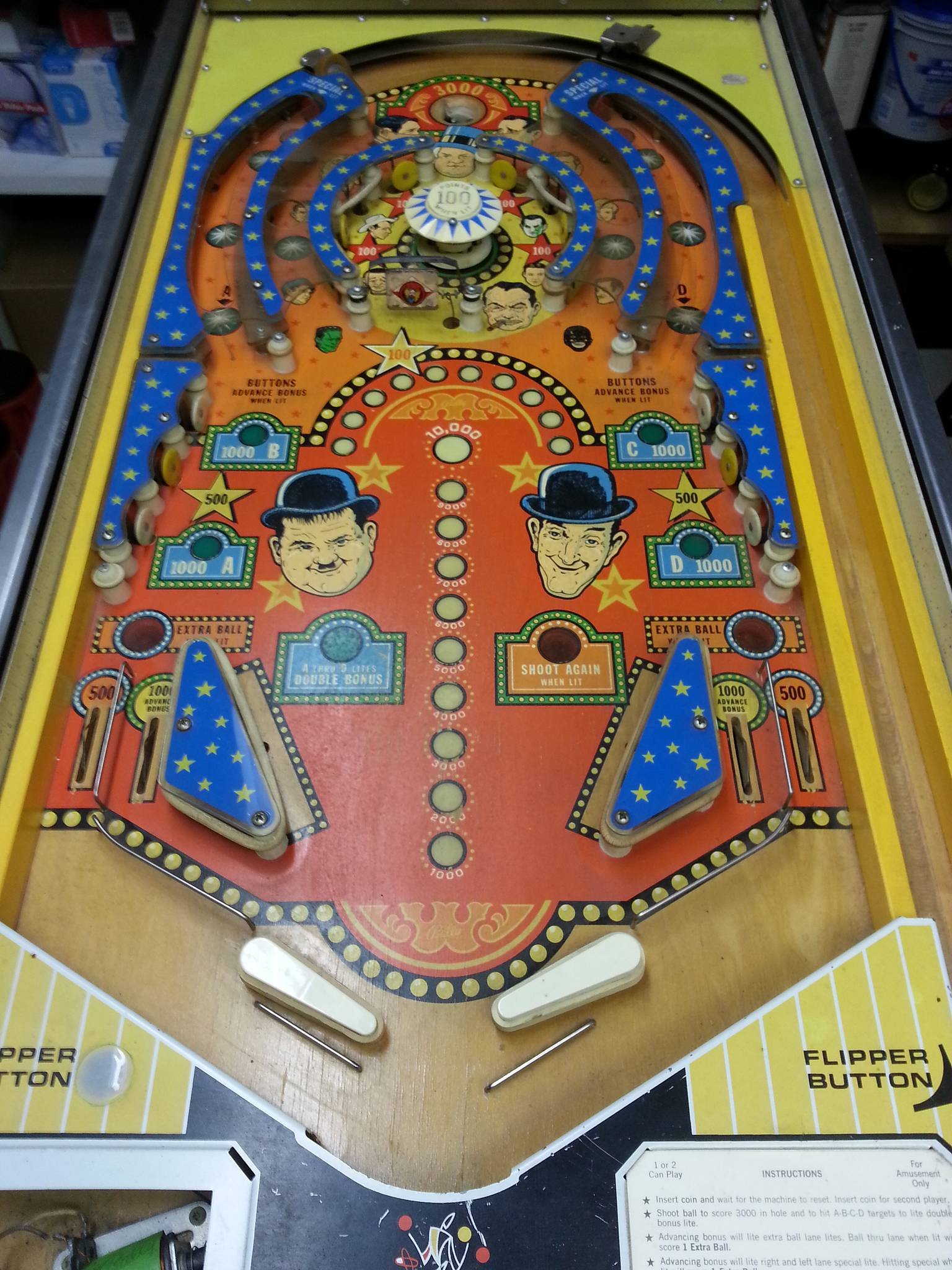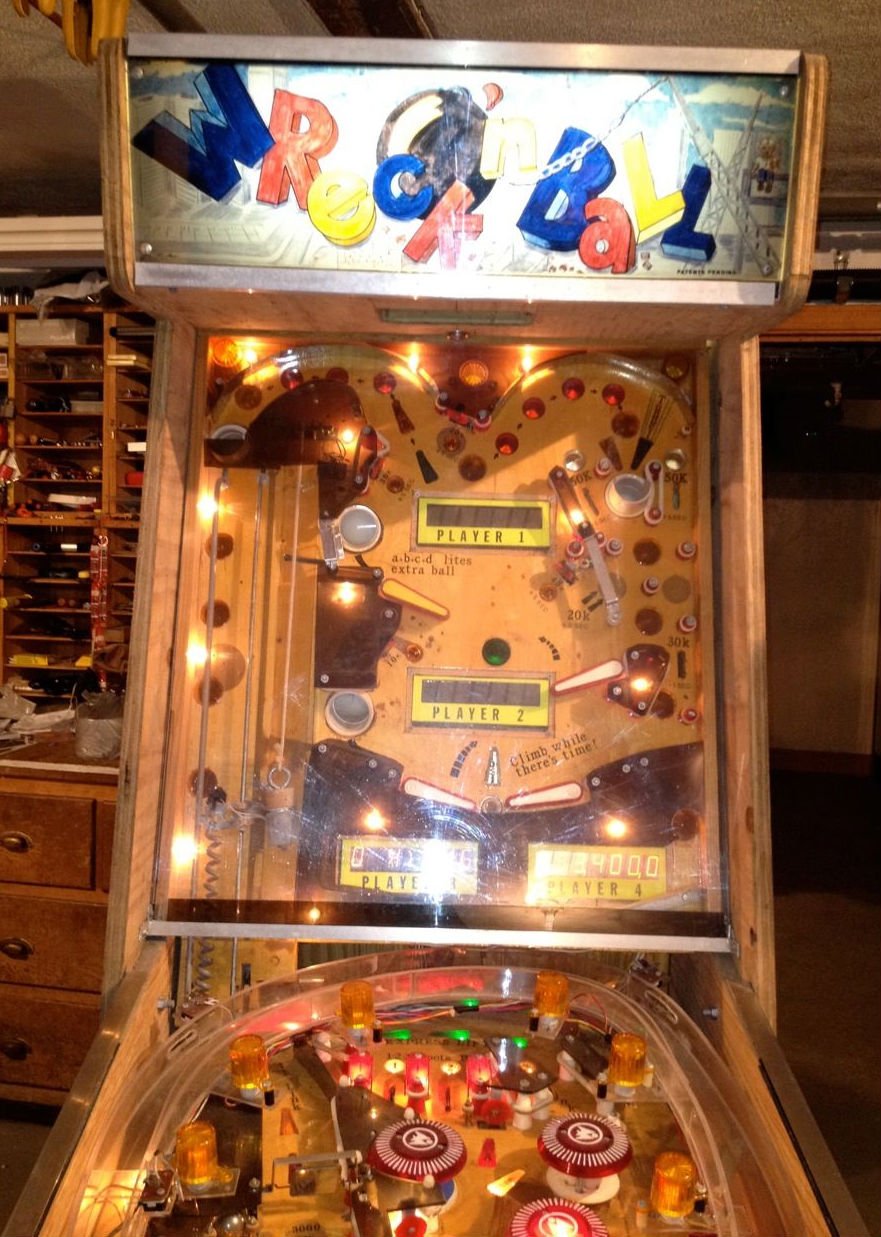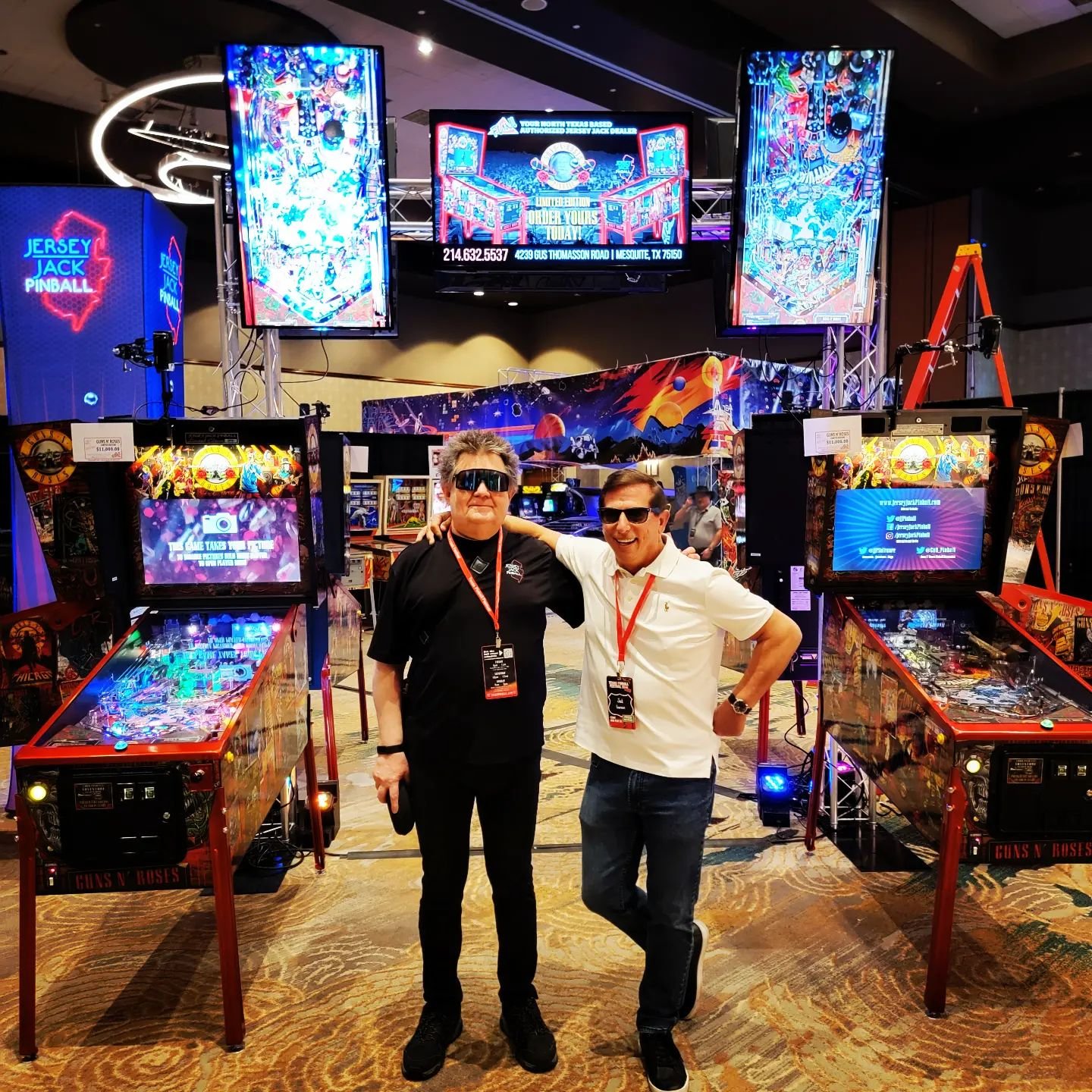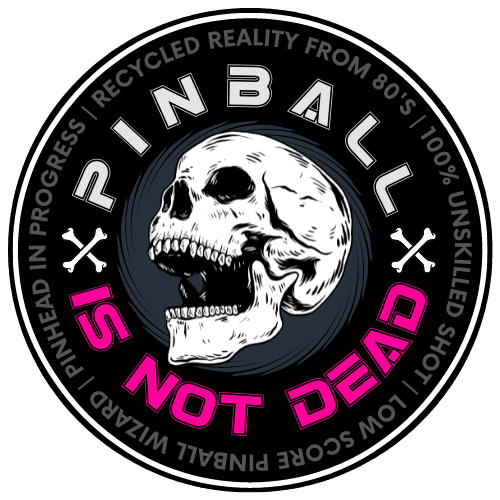In the Pinball Hall of Fame, Pat Lawlor will probably have a special place, as the machines he designed have left their mark on pinball history. Moreover, he is one of the few designers to have bounced back from the demise of the Bally/Williams company. He has thus left his mark on two very different eras.
The release of this article also coincides with the retirement of this monument, and raises the question of his succession at Jersey Jack Pinball. But let’s start things in order.
Sommaire
- 1 An early career in video games
- 2 The beginning at Williams – Banzai Run
- 3 Pat Lawlor’s “natural disaster” pinball machines
- 4 The 3rd flipper
- 5 The consecration : FunHouse, Addams Family, Twilight Zone
- 6 The Addams Family, the cult object of the 90s
- 7 Twilight Zone: Lawlor has carte blanche
- 8 Roadshow: Rudy’s twin children from FunHouse
- 9 The decline : Safe Cracker and No good Gofers
- 10 Pinball 2000: fireworks and the end of the Williams adventure
- 11 The best move of the 2000s?
- 12 Lawlor’s Pinball machines in the Stern era
- 13 Pat Lawlor: a genius but not a seer
- 14 The recruitment by Jersey Jack Pinball
- 15 The last hit: Toy Story pinball
- 16 Who will take over?
- 17 Pat Lawlor: the legend
- 18 Sources for this article on Pat Lawlor
An early career in video games
Pat Lawlor was born in 1951, but his official history doesn’t begin until 1987 at Williams. What were his first experiences?


Does Dave Nutting Associates sound familiar? No ? It was an innovative subcontractor of Bally and Midway Manufacturing: at the crossroads between video games and pinball, its founder Dave Nutting firmly believed that the microprocessor would be the future of arcade games.
As an experiment, the firm implemented a brand new Intel processor in a Flicker pinball machine, a license based on an early Laurel and Hardy movie. It was the first experiment of its kind!

However, the company’s main focus was on arcade and home consoles, such as a very decent pinball video game called Bally Pin, designed for the Bally Astrocade machine.
Bally company eventually bought Dave Nutting Associates in the late 1970s, and liquidated it following the crash of the video game industry (console and arcade) in 1983. The causes of this crash are multiple, but let’s mention a saturation of the market with poor quality games, and the competition of home computers. We are talking about a 97% drop in the home console market in the space of two years!
Just before its disappearance, the team released its most original machine, a mix of arcade and pinball machine: baby Pac-Man.
Pat Lawlor is hired in 1980 as a video game designer. He works on the video game The Adventure of Robby Roto. He starts a prototype called Demons and Dragons but it will be cancelled because of the crisis of 1983. A project that stops from one day to the next is a violent experience for those who live it, and unfortunately Lawlor will live it twice in his career, leaving him a bitter taste.
Working in such a creative company probably developed his taste for innovation. Bally’s tutelage and Dave Nutting’s experiments in pinball enriched his resume enough to apply to Williams.
The beginning at Williams – Banzai Run
In 1987, Lawlor joined the Williams team as an engineer, although I must admit I don’t understand why he wasn’t called a designer from the start.


His first project is a co-creation with Larry DeMar. Larry had joined the manufacturer several years earlier, in 1980. However, the two acolytes were more or less the same age.
The first creation of the duo is Banzai Run, based on a concept of Pat Lawlor. He had tested the idea before on a prototype called Wreck’n Ball, also with the help of DeMar. It’s nothing more and nothing less than two pinball machines in one: in addition to the horizontal board, the front panel is replaced by a second almost vertical board. Both playfields are played in the traditional way, except that gravity makes it difficult to control the ball on the vertical part. The ball goes from one board to the other by a small magnetic elevator.
“Once again, Williams takes you where no one else has ever gone before!” – Advertising slogan
The machine was not a great success, as only 1,751 units were produced, a volume qualified as confidential for the time. Unbridled innovation is all very well, but when it does not meet the needs of the operators, the backlash is quickly felt: two platforms, twice as much maintenance for equivalent revenues.
By the way, Banzai Run is the first machine to include an attract mode, the little demonstration that starts when you press one of the two buttons without having put a coin in. This is the work of DeMar.
Pat Lawlor’s “natural disaster” pinball machines
Lawlor was then able to develop his projects on his own (i.e. being the only designer). His next two machines, Earthshaker and Whirlwind, gave him the opportunity to impose his style.
A “Lawlor” pinball machine is often distinguished by a toy or an element on which the gameplay is based. For example, Earthshaker is the first pinball machine to include a… Shaker, yes well done! But contrary to its current use, which punctuates any action, here it simulates an earthquake when you reach the seismic fault. Moreover, on the first models released, this pinball includes a building, the Institute, which collapses during a certain phase of the game. Oh, like Keith Elwin’s Godzilla pinball! The feature was ultimately not retained for the rest of the Earthshaker production.
As for the Whirlwind pinball machine, the “killer feature” consists of 3 discs inserted into the playfield that spin around to simulate tornadoes. Each disc has a rubber outline to increase the grip of the ball. Thus, the trajectory of the ball is altered, a bit like a leaf in the wind.
Oh I forgot: the topper of the whirlwind is a fan! What a sense of detail!
The two machines reach more than 5,000 units, a score within the norm of good sales at the time, but still far from the successes that await the designer.
Nevertheless, the video below shows a happy man, fulfilled in his job, which will not always be the case, as we will see later.
The 3rd flipper
Besides the crazy toys, Pat Lawlor likes to add a 3rd flipper in the middle of the playfield on one of the sides. This one is the only access to an element (usually a ramp) located on the opposite side. We find this marotte in a significant number of his productions, and it makes them less easy to play than other machines, because to complete certain missions requires to aim twice in the same stride: one to position the ball at the level of the 3rd flipper, the other to succeed in shooting with it.
Of course, this 3rd flipper (and sometimes the 4th one) is not exclusive to the designer, but rather a recurring element of his machines, much more so than in the rest of the pinball production. In fact, this fad has followed him through the ages, as it can be seen in his productions from the 1990s, 2000s and 2010s. Keith Elwin, who is obviously inspired by Lawlor, is also a fan of it (see Jurassic Park or Godzilla).


Another whim of our designer: the double inlanes on one side of the pinball machine, as on the picture above. Mechanically, this practice limits the number of balls that will end up on the outlane, and this is not a pity considering the recurrent difficulty of Lawlor’s creations.
The consecration : FunHouse, Addams Family, Twilight Zone
In souls nobly born valor does not depend upon age… Our friend Cornelius is really mistaken about Lawlor. The designer waited until he was 40 years old to reach the heights of his art. He then made a legendary triple in the space of 3 years.
In 1990, Pat Lawlor launched the FunHouse pinball machine, a typical table of the designer:
- A single toy but very original because it is a talking head that comments the action and follows the ball with its eyes
- The famous 3rd flipper that allows to hit Rudy’s mouth (and not a ramp)
- An ultra coherent universe on an original theme (the fair closing its doors)
- A game that requires a long appropriation time, and that one can find austere
The concern for coherence goes far in Lawlor: in order to give the illusion that Rudy, the talking head, has a personality, the players are randomly called Chucky, Spunky, Bucko, or Slick during a multiplayer game. If you are unlucky enough to be called the latter, the callouts vary to be more sarcastic. Obviously Rudy doesn’t like Slick.
Another anecdote: the clock on the Twilight Zone pinball was originally planned for the FunHouse game, but there was not enough time to make the toy technically reliable. So the designer preferred to replace it with a “digital” version on the board, based on inserts to simulate the advancing time.
This was Lawlor’s first major commercial success: 10,751 units produced!
The Addams Family, the cult object of the 90s
The Addams Family pinball machine (TAF) may have been Pat Lawlor’s greatest success, but it stands out from the rest of his inventions in several ways.


First of all, it is his first adaptation of a license. And not just any license, given the success of the film. Using a license brings constraints in the design and artwork as much as it facilitates sales, which Pat Lawlor had not been confronted with until now.
Here, no predominant toy, but a balanced layout with points of interest everywhere. A bit like on George Gomez’s Monster Bash pinball, which will be released 6 years later.
2 additional flippers come to decorate the parts, there we remain in the DNA of the designer. I won’t say more, as Syl Vain has already said a lot in his article about this The Addams Family pinball machine.
Let’s just remember that TAF was the best-selling pinball machine of all time, exceeding 20,000 units produced. This record earned it a Gold edition released 2 years later, in 1994.
Twilight Zone: Lawlor has carte blanche
Intuitively, one thinks that if a genius can create without constraint, the result will be memorable. This is very often a misconception. Without constraint, one wants to do a lot, even too much. The result is rich, it feeds the analysts for years, but often lacks the simplicity necessary for a mythical work. This is what happened to Pat Lawlor with his pinball Twilight Zone.
After the unparalleled success of the Addams game, Pat Lawlor had carte blanche for his second license. The result is a pinball game full of toys, intelligent and unstructured, but punishing and complex (some would say complicated).


The machine sold admirably (15,235 units), but only because operators bought it with their eyes closed. It was a mistake! The famous clock, already planned on the FunHouse pinball but abandoned, often broke down. Moreover, the profusion of original parts made its maintenance a nightmare.
TZ is both the quintessential art of its designer, a collector’s item without a doubt, but probably not the pinball machine you’ll have the most fun on, nor even the darling child of its designer.
Roadshow: Rudy’s twin children from FunHouse
Lawlor is a reasonable man. After the artistic delirium that was Twilight Zone, our designer returns to a simpler design that he has already mastered. The Roadshow game, released in 1994, welcomes on its board a duo of construction workers, whose technology is equivalent to Rudy’s. The gameplay is much more obvious, without being simplistic.
Pat Lawlor goes back to his comfort zone, with an original theme, which will generate very good sales (almost 8 000).
The decline : Safe Cracker and No good Gofers
While the designer continued to make progress with two original pinball machines, the market fell apart. Sales collapsed (less than 3,000 per model), not paying tribute to the quality of the machines invented by Lawlor.
The Safe Cracker machine, released in 1996, stands out in two aspects:
- A much more compact box and a front panel with two flaps that close, thus imitating a safe
- Tokens distributed to the player when he succeeds in certain missions, and whose function depends on the operator’s wish: a free game, access to a prize provided by the operator, or simply a souvenir
The No Good Gofers game, released a year later, is one of those underrated pinball machines. The unpretentious artwork and the deceptively childish theme may not help it. However, the machine does not fall short in Lawlor’s list of achievements. The main innovation is a removable springboard that allows to send the ball on a plexiglass plate overhanging the bottom of the board. This second glass has a “hole”. It is a shot that is both arduous and enjoyable, well in the spirit of the designer’s other creations.
Pinball 2000: fireworks and the end of the Williams adventure
At the end of the 90’s, saving pinball is a question of survival for the manufacturers. Williams stopped all its current projects, including the Cactus Canyon pinball machine, the code of which was not completed (but the machine was still marketed).
The company’s best minds, led by Pat Lawlor and George Gomez, are thinking about a new generation of machine: Pinball 2000, a mix of traditional pinball and computer that plays on transparency to enrich the background with interactive videos.
The machine is a critical success, the innovation, on several aspects, is spectacular. For example, the software and the playfield can be changed, allowing the “cabinet” to host another game.
Unfortunately, the Pinball 2000 concept will never be a commercial success. Here is the explanation given by Pat Lawlor in an interview in 2009:
“The answer to whether or not Pinball 2000 succeeded has never been answered. Williams was in the process of becoming a gaming (slot) company and wanted very badly to be out of the pinball business. That’s because the stock analysts hated that they couldn’t value the stock correctly as long as the old vestige part of the company still survived. Since there were no buyers for the pinball group at its write-down value, it was economically smarter to close the business and take the write-down valuation on the books. It was also smart never to let the world know if another company could have made a go of it, since at that time, pinball was still a market share threat to one of the sister companies.” gamedeveloper.com
In short, according to Lawlor, the financiers sacrificed a business before even knowing if it could rebound in 1999. The Pinball 2000 concept paid the price.
In this context, here is the second aborted project of our creator: Wizard Blocks, a pinball machine based on the Pinball 2000 technology, but which never went beyond the “whitewood” stage, i.e. the rough wooden model.
Like all Bally/Williams employees, Pat Lawlor had to bounce around.
The best move of the 2000s?
What do designers do when they leave Williams? The answers vary:
- George Gomez joins the fledgling company Stern Pinball
- John Popadiuk goes into entrepreneurship and fails several times (see previous article)
- Barry Oursler lands with a distributor
But Pat Lawlor, for his part, created his own pinball design subcontracting company: Pat Lawlor Design (PLD). Although the company’s name uses his surname as a signature, he does not work alone. Indeed, his acolytes from the Williams era have followed him:
- John Youssi, in the artwork
- John Krutsch as mechanical engineer
- Louis Koziarz in code
PLD signs a partnership with Stern Pinball, the former designing the machines while the latter manufactures and distributes them. Lawlor therefore has a particularly enlightened analysis of its added value on the market, and focuses on it. No investment is necessary, only intellectual service… It’s smart!
Moreover, Lawlor secures the fact that it works on a daily basis as it did during the Williams era: a small team dedicated to a single project at the same time, and very autonomous.
Lawlor’s Pinball machines in the Stern era
The productions of the 2000s are not generally remembered. Clearly it was the low point for the whole market. Nevertheless, let’s remember a few PLD creations during this period:
- Monopoly in 2001
- RollerCoaster Tycoon in 2002
- Ripley’s Believe it or Not! in 2004
- Family Guy in 2007


Pat Lawlor doesn’t seem to have had much fun, and the man seems bitter at the end of the 2000s. Still in the same 2009 interview mentioned above :
“Stern is a 180-degree different environment from what Williams was. At Williams, the game designers were the creative driving force at the company. We were pretty much allowed to make what we wanted including picking our own themes for our projects. At Stern, the theme is now universally picked by management. The game designers are trapped into working on projects they otherwise might never have chosen.
[…] I have never believed large groups do great things. They do good things, but not great things. Large groups lead you astray because they are never interested in radical concepts and chances. That’s why companies driven by “focus” groups generally make such vanilla products. Focus groups are a way of management covering their rear end instead of trusting their talent.“
(Editor’s note: a focus group is a small sample of representative customers who are asked to test new products or concepts)
This bitterness may come from the fact that the partnership with the manufacturer is coming to an end, with the last co-signed pinball machine dating back to 2008.
Pat Lawlor: a genius but not a seer
Something has broken in our designer, in the late 2000s. He even predicted the end of pinball within 5 years at the 2007 Pinball Expo in Chicago. When gamedeveloper asked him what it would take to revive the pinball market, this was his answer in 2009:
“Pinball has not adequately adapted to the 21st century. Pinball machines that are being made today are basically the same machines that were being made in 1992. Except for some collectors and a few die-hard locations, the game is considered to be irrelevant by the general population. Without changing the game to appeal to today’s technology-driven audience, it will die a slow but certain death.”
However, the 2010s prove him wrong, with a new craze, the arrival of new manufacturers. The size of the market has nothing to do with the 80’s or 90’s, but the recovery is there, based on machines that remain basically the same, and prices that are soaring. Lawlor did not anticipate it. Genius certainly, but not a seer.
The recruitment by Jersey Jack Pinball
Among these new manufacturers created in the early 2010s, Jersey Jack Pinball is set to become the challenger of Stern Pinball, if not on volumes, at least on innovation. Notably, we owe JJP the first LCD screens and LEDs instead of filament bulbs.
In early 2014, Jack Guarnieri, JJP’s ambitious founder, rolls out the red carpet for Pat Lawlor to join the venture. That red carpet comes with the promise of generous trays and a license-free theme for the designer to choose from, all the right stuff to lure our veteran. Here’s an excerpt from the release at the time:
“The game will be an original idea enabling Pat and his Team to imagine and to create. If you are a true pinball enthusiast you are going to love this pinball machine”, says Jack Guarnieri, the founder of JJP.
The pinball turns out to be Dialed In, which was released in 2017. This is probably Lawlor’s most bizarre theme. While everyone remembers the Bluetooth connectivity and the camera (all tied to the smartphone that graces the board), everyone quickly misses the theme: disasters befalling Quantum City! Yes, it’s the return of the “disaster theme” that inspired Lawlor in the 90s.
The pitch is as follows: you mistakenly get a phone that seems to cause a chain of disasters, such as a tidal wave, a volcanic eruption, a tornado, an EMP (electromagnetic nuclear pulse) strike, an earthquake… You are faced with 11 different events. Activating them all triggers one of the two wizards modes, the other one starting when you collect 8 SIM cards generating the problems. Not sure if this scenario is the most suitable for a medium as “visceral” as pinball is. And the connected functionality seems more of a gimmick for communication than a real added value for the player.
Nevertheless, we find on this machine original toys. And the flow is at the same time difficult and satisfying. This is Pat Lawlor’s big comeback, no doubt about it.
The second machine of Lawlor for Jersey Jack Pinball is Willy Wonka and the Chocolate Factory. Except that it is a license from the 1964 movie (not the one with Johnny Depp), the rest has the ingredients we like.
These two JJP pinball machines are described as “sleepers”, i.e. underpriced tables, which will most likely gain in value over the years. After almost two decades of Stern Pinball calibrated licensed pinball machines, JJP and Lawlor are digging a groove of generous machines under the glass, but perhaps of less mainstream access. Building a customer base takes time, no matter how good the product.
The last hit: Toy Story pinball
At the time of writing, JJP has just announced the release of Pat Lawlor’s latest pinball machine from the Toy Story license. It is the latest but also the last machine designed by Lawlor. He should indeed retire at the same time, at 71 years old.
Expectations were enormous, as the animated film appeals to all generations, and as JJP was able to create envy around the releases of his star designer. These expectations are hard to satisfy, considering the first feedbacks, but to know everything, read the preview on the Toy Story pinball.
For his latest creation, Pat Lawlor uses mechanics already proven on the machines that have marked his career. The best example is the removable springboard that makes the ball take off and land on a plastic plate. A real reminder of the No Good Gofers pinball machine mentioned above.
Some people find this pinball machine less rich in toys than the other creations of Jersey Jack Pinball. I would say less unstructured, more accessible. In the interviews he gives, Lawlor is very clear about his desire to make a general public pinball machine, like the license he is inspired from. And to facilitate the shots, it is preferable to position the elements at the bottom of the playfield. Lawlor knows the good practices, he knows how to play it to respect the license he was given. Hats off to him! History will certainly prove him right.
Who will take over?
You don’t replace Pat Lawlor, you succeed him. His conception of pinball is so particular that he can have emulators, but no one really follows in his footsteps, no matter how good the new designers like Eric Meunier or Keith Elwin are.
Jack Guarnieri trusts Steve Ritchie to play the role of the great sage. The man will probably deserve his own article one day. He started in the 70’s, worked at Williams in the 90’s, then was hired at Stern in the 2000’s. He is responsible for famous pinball machines like the Black Knight series, but also Star Trek: The Next Generation, AC/DC pinball… His last pinball machine has been criticized: Led Zeppelin.


It is possible that the more than mitigated reception which was made to the machine is at the origin of the rupture between Ritchie and the firm of Gary Stern. A godsend for JJP!
Even if it is not official, we suppose that the new recruit will take over from Lawlor as “Head of Game Design”. However, Steve Ritchie is one year older than his predecessor.
Pat Lawlor: the legend
Pat Lawlor deserves his place among the greatest designers. His touch has never suited everyone, but those who do swear by it.
In any case, let’s face it, he’s a bold and brilliant man who never rested on his laurels. Even his “commercial failures” (everything is relative) remain outstanding works that less talented designers envy him.
Long live Pat Lawlor! And just for fun, a last video of the man explaining the evolution of the pinball manufacturing process between the 90s and today.
Sources for this article on Pat Lawlor
Here are the sources that were not specified in the article and that allowed the collection of information. For the history of Pat Lawlor in general and in detail :
- Wikipedia
- Pat Lawlor’s interview in 2009 at gamedevelopper.com
- The pinballnews article on the creation of PLD
- PLD’s website
For some info on Nutting Associates
For Pat Lawlor’s pinball summary:
For the rules of Dialed In :
For background on industry events:

